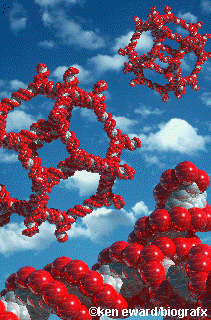
Joint Penn-UDel Seminar on DNA Computing
Control of DNA Structure and Topology: DNA Branches, Polyhedra and Knots
Nadrian Seeman
Department of Chemistry,
New York University

Artistic rendering by Ken Eward of a DNA truncated
octahedron constructed in Seeman's laboratory.
The control of structure on the nanometer scale is a key goal of
molecular biophysics, materials science and nanotechnology. We use the
specificity of DNA complementary to direct the assembly of discrete DNA
structures; for example, we have assembled catenated molecules whose helix
axes have the connectivities of a cube and of a truncated octahedron. The
topological control afforded by this system has stimulated us to make DNA
knots. Trefoil knots of both signs and a figure-8 knot have been
constructed, and an RNA knot has been used to demonstrate the existence of
an RNA topoisomerase. We have suggested that periodic arrays (crystals)
of DNA objects could be used to direct the assembly of biochips. In order
to exploit DNA assembly to construct periodic matter, it is necessary to
identify rigid DNA motifs. We have found that the antiparallel DNA double
crossover molecule behaves as a rigid unit. These molecules have been
adopted by Erik Winfree as the components used in his approach to DNA
computing by cellular automata.
Thursday, February 20, at 4:30PM in room 302 of the Clinical Research Building of the Medical School on the University of Pennsylvania campus.